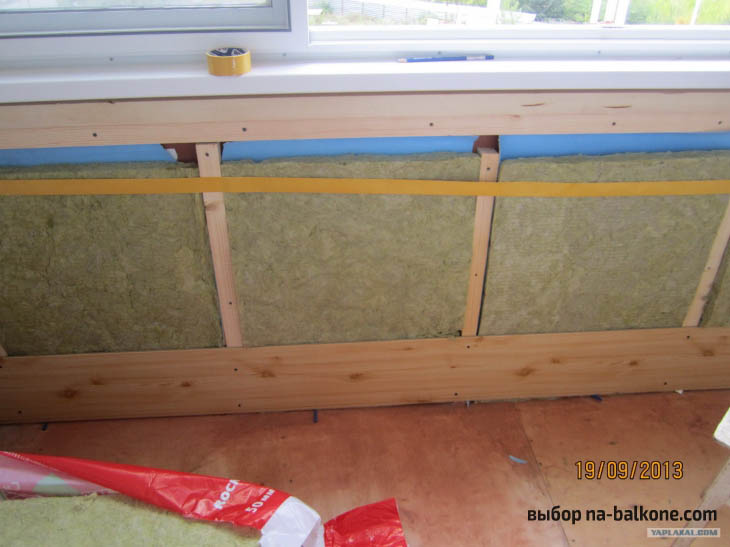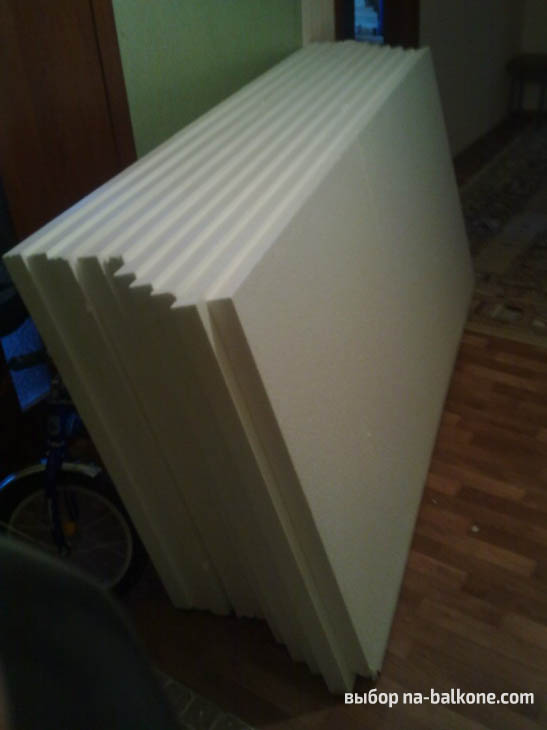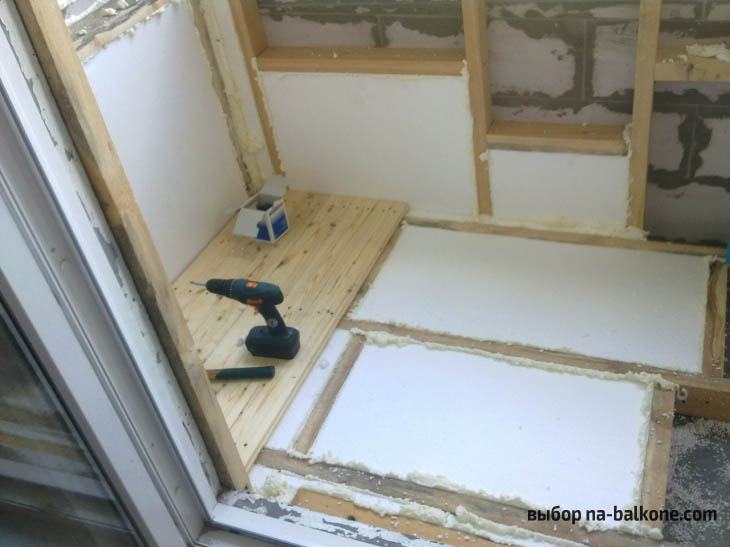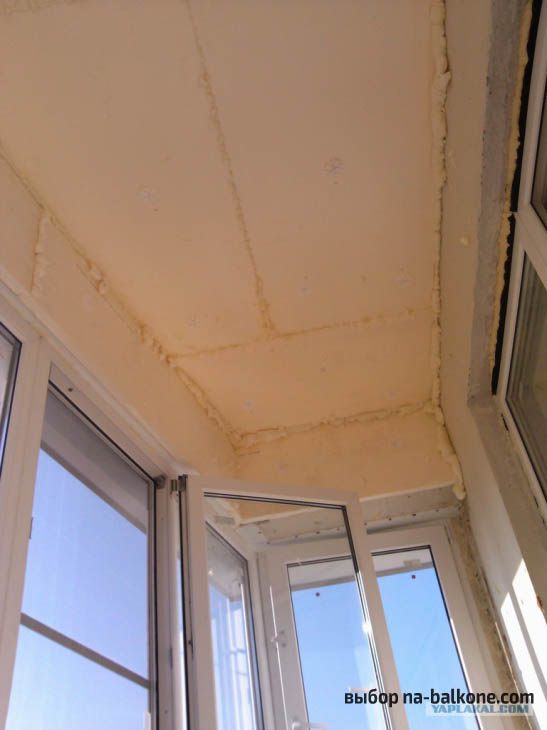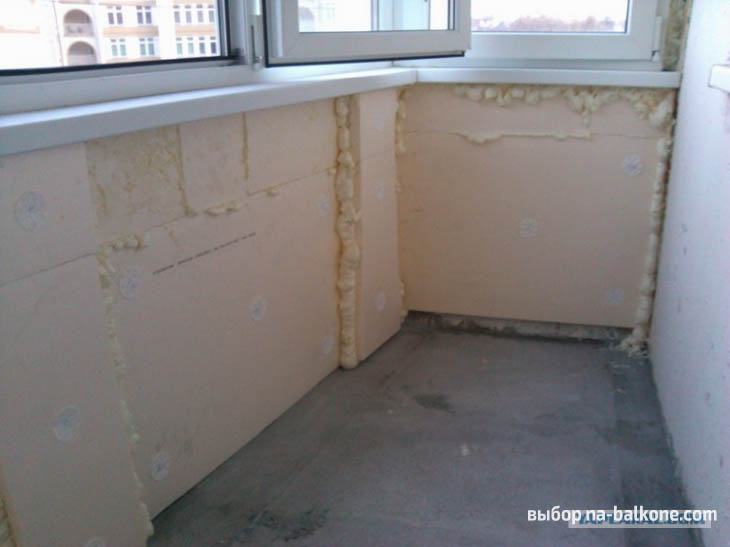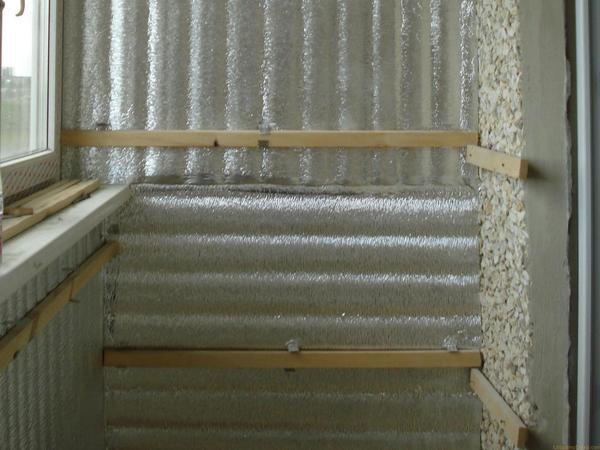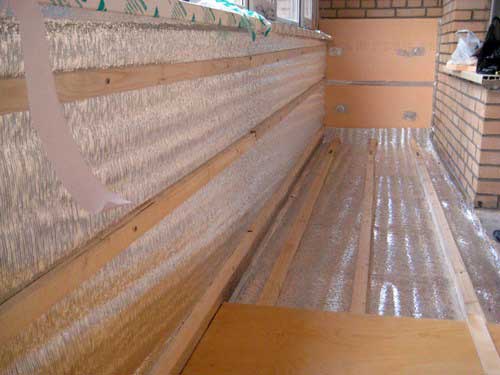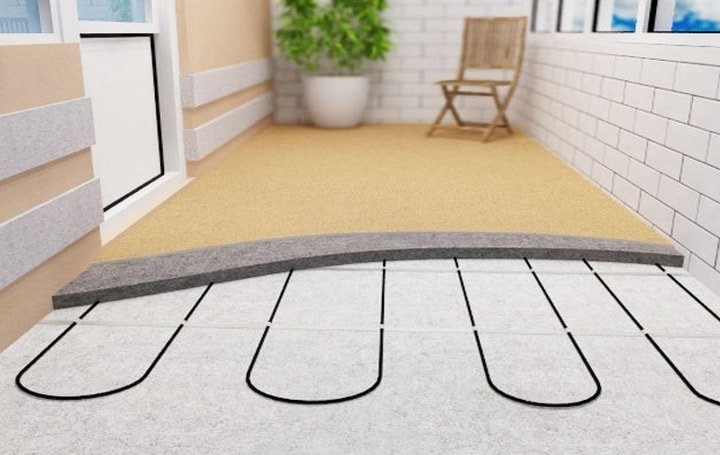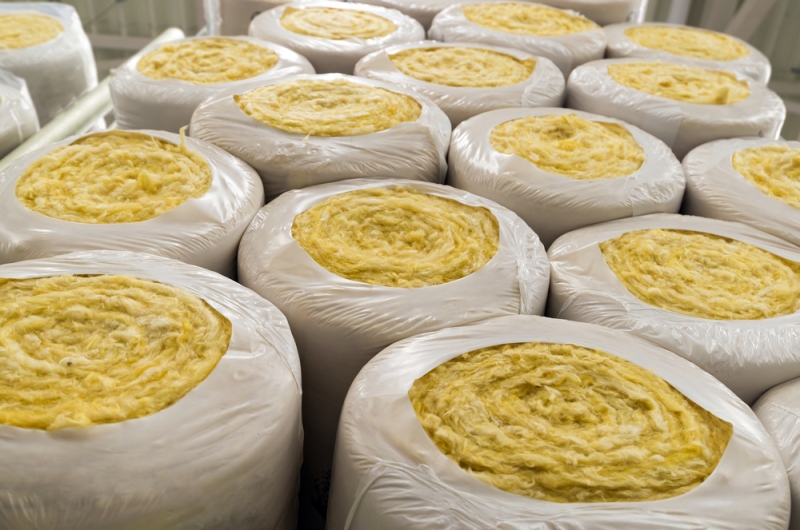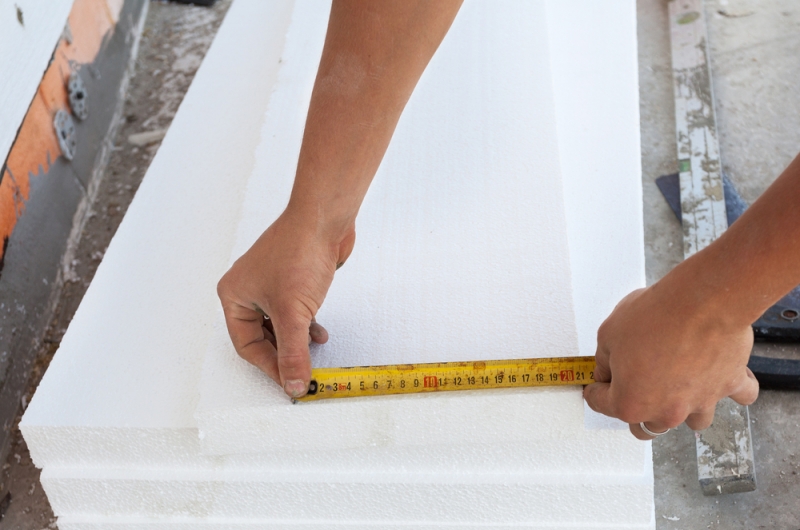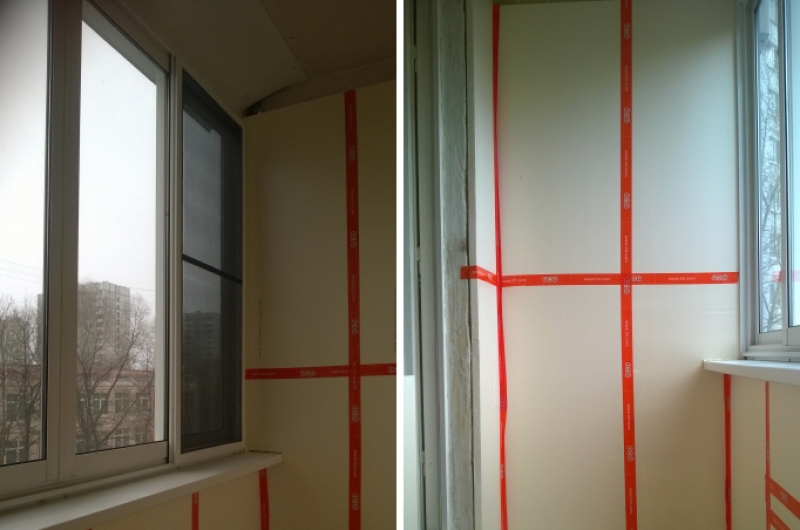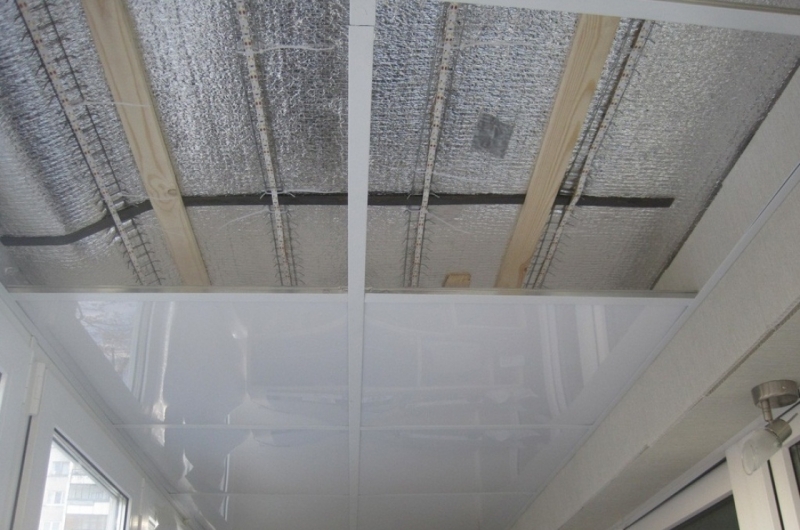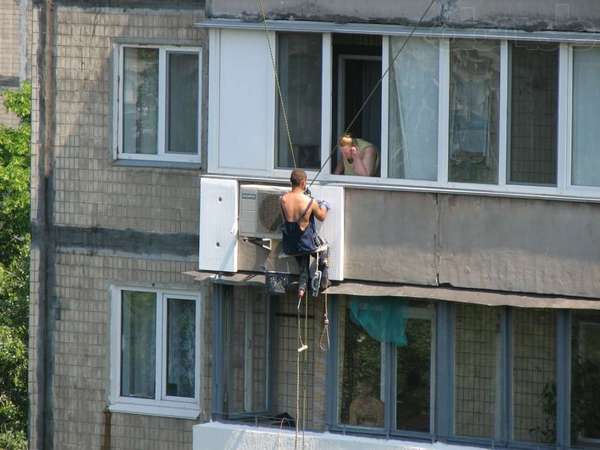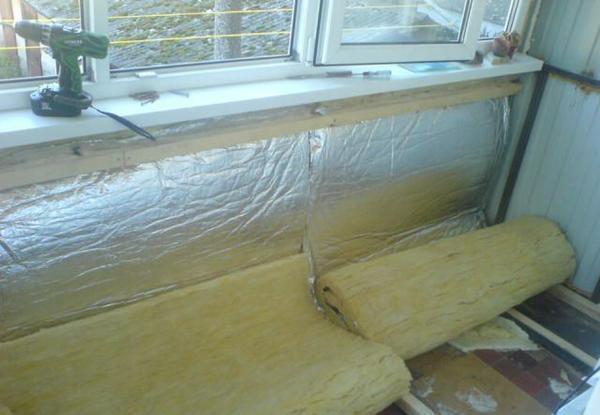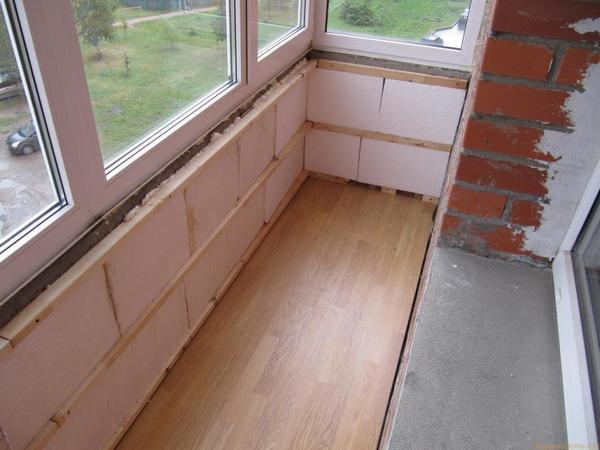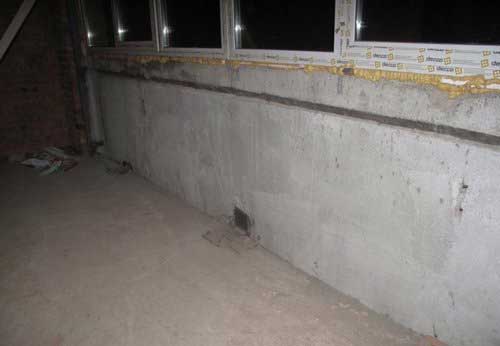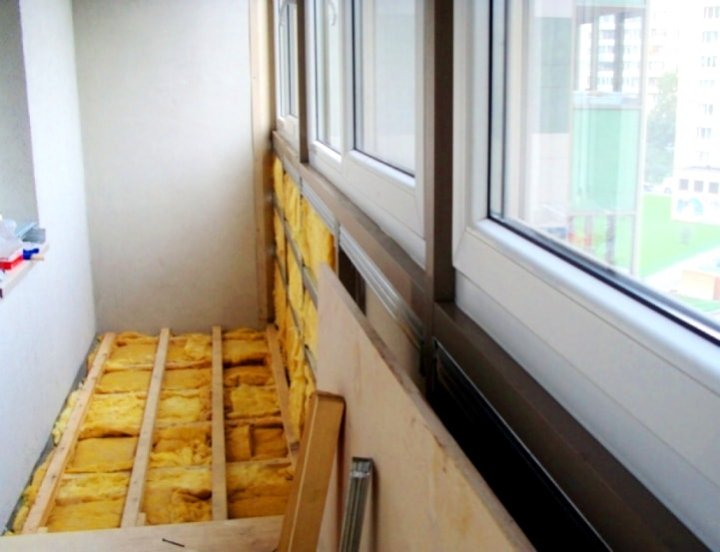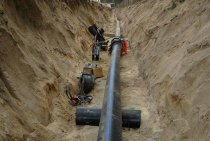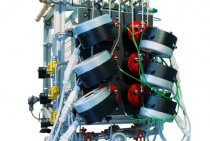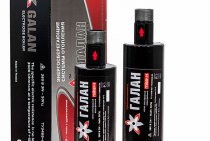The choice of heat insulator
Advantages and disadvantages are inherent in each type of thermal insulation. In order to choose the most suitable insulation, you should compare the main characteristics of heat insulators.
The most common options for heat insulators:
- Extruded polystyrene foam (penoplex);
- Foamed polyethylene (penofol);
- Polyurethane foam (PPU);
- Styrofoam;
- Mineral wool.
Mineral wool
The thickness of the sheets varies from 2 to 20 cm. Mineral wool is divided into three types, depending on the components of the raw materials:
An example of a mineral wool device on a loggia. The material is placed in the prepared structure. The frame for mounting can be made of metal profiles or wooden bars.
Manufacturers produce cotton wool in the form of mats and soft rolls. In some cases, one side is covered with foil. Aluminum foil improves the level of thermal insulation.
The main disadvantage is that moisture acts destructively, a vapor barrier device is necessary.
Polymer-based insulation
Penoplex, polyurethane foam, polystyrene, foamed polyethylene are polymers treated with foamed compounds.
Advantages:
- The presence of gas bubbles provides not only a good level of thermal insulation, but also a small weight of the plates;
- High degree of moisture resistance;
- The materials are durable;
- Antifungal resistance;
- Simplicity and convenience when laying plates or sheets, as well as rolls (polyethylene foam);
- An economical repair option, subject to the choice of foam as a heater.
The main disadvantage: they support the spread of flame during a fire, emit harmful substances during combustion.
When choosing foam and other materials based on polymers, it is necessary to correctly select the thickness of the plates and determine the density
1. Styrofoam sheets
Insulator plates (expanded polystyrene) in the process of laying.
Styrofoam refers to budgetary methods of warming a loggia, however, it is considered a rather fragile material, therefore, a crate is necessary for installation. A worthy replacement is extruded polystyrene foam; its installation does not require the creation of a special frame.
2. Penoplex
Extruded polystyrene foam boards (thickness 50 mm) are used as insulation. The seams between the elements are sealed with mounting foam. Penoplex is attached with the help of special dish-shaped dowels ("fungi").
3. Penofol
The material is used as a separate heat insulator, and with the help of penofol it is possible to provide a vapor barrier of expanded polystyrene. Due to the foil side, warm air is reflected and retained in the room.
In order to speed up the insulation of the structure, you can use an alternative method of thermal insulation - spraying polyurethane foam (PPU).
4. Polyurethane foam
PPU is one of the most modern heat insulators. The cost of application services is considered high compared to other analogues, however, many have managed to evaluate the performance properties of PPU. This insulation is characterized by high thermal insulation performance, due to the finely porous structure.
How to lay insulation for a balcony indoors
After we have decided on the material for wall insulation, and the method of doing the work, we need to draw ourselves a plan for the next steps. It should consist of construction stages and periods for completing tasks. Once again, evaluate the possibilities of your balcony. If you do not already have energy-saving windows, then now is the time to install them. You are doing a major overhaul of the cladding, and it will be difficult to return to it later, and installing plastic windows will require strengthening the positions that support them.
Then, step by step, according to your own plan and studying the feedback of specialists, move forward. Immediately consider how you will decorate the walls of your balcony. The method of laying the insulating material during further cladding of the balcony with clapboard or plastic differs from the insulation of the balcony without further cladding.
Step-by-step instructions for warming a balcony:
- If your windows are already installed, then we start by sealing cracks, cracks and damage. Check the wood paneling for rotten boards and fungus. If they are, then take steps to eliminate them. If there are no plastic windows, then you need to install them.
- In the event that you will later sheathe the balcony with clapboard (which is done very often), then you need to start arranging the crate.
- Consider electrical wiring. Do the wiring in advance so that you do not have to spoil the repair later.
- We begin the warming process. Lay insulation in the space between the battens of the crate, attaching it in accordance with the type of material.
- Seal the gaps between the insulation, if it is solid.
- Seal the joints with mounting tape.
- For greater thermal insulation, lay a layer of penofol on top.
- Level surfaces.
- Line the walls with finishing material.
When carrying out work on the balcony, one rule should be taken into account - to repair the balcony, choose the lightest finishing materials. The balcony is a special design, and it should not be overloaded.
6 best heaters for a balcony
The glazed balcony becomes another room where you can relax, work or even sleep. But double-glazed windows do not provide complete thermal insulation, and the efficiency of the convector installation is reduced due to heat loss. To ensure sufficient temperature on the balcony and save on heating, we present a rating of the best balcony heaters. These materials are laid between the outer wall and the inner skin, increasing heat and sound insulation. TOP-6 is based on the characteristics of the goods and the reviews of the masters, so it will help you look objectively and choose the right insulation.
Internal insulation of the walls of the loggia which material is more reliable
The loggia, from a constructive point of view, is perfect for becoming a full-fledged room or an extension of the apartment. To make this possible, it is necessary to carry out a number of construction and installation works on insulation, glazing, and finishing. The result is a cozy room for relaxation, a spacious living room, an additional place to work.
The result of insulation may differ from the desired one, if several factors are not taken into account when choosing materials and technology for insulation work.
The first factor is the further purpose of the premises:
if it is supposed to have a utility room, then any insulation in one layer is used; thermally insulated, basically, only the part directly in contact with the street - the parapet;
the desire to have a separate full-fledged room will require the use of different types of heat-insulating materials that are stacked in two layers over the entire surface of the loggia;
the option of combining a loggia and a room will also require two-layer insulation, but in this case the main attention is paid to the parapet, and the walls are covered in one layer.
The second factor is the size of the loggia itself, since if it is small, then such a heater is selected, which, with a small thickness, has a sufficiently high thermal protection index. In this case, the useful area will be reduced slightly.
The third factor is taking into account the fact that any material from which the walls of the interior are made passes moisture accumulated inside. These water vapors, colliding with the colder air of the street, settle on the outside of the wall. If this wall is insulated, it means that the insulation is covered with moisture, which leads to its decay and a decrease in thermal insulation properties.It is necessary that water vapor does not reach the heater.
Penofol
This material is polyethylene foam covered with polished foil. Penofol is flexible, lightweight, water and vapor impermeable, has good thermal and sound insulation properties. Penofol is foiled on one side or on both sides, and some have a self-adhesive base. Penofol when insulating loggias is used in conjunction with other insulating materials such as foam. To insulate the loggia with foam plastic without penofol, you will need to use a very thick foam plastic, and in a combined one 40 mm thick.
Do-it-yourself step-by-step warming of the loggia step by step instructions photo
First, the loggia is insulated with foam foil 5 mm thick with foil inside and fixed to the bars with staples. Styrofoam sheets are laid on top of it. It is necessary to foam all the seams in the foam with mounting foam. On top of the foam, 3 mm foam foil is laid inside the room with foil and is also fixed to the bars with brackets. If a joint forms between the foam sheets, it is foamed and then sealed with foil tape. After that, a crate is attached to the bars, which will create an air gap between the insulation and the finishing material. The crate can be made of wooden slats with a section of 2 by 4 cm. The slats are nailed perpendicular to the bars every 40-50 cm. When insulating the floor on the loggia with your own hands, you do not need to do the crate. Larger cross-section bars can be laid on the floor so that a gap of at least 1.5 cm is created between the insulation and the floor covering. After laying the insulation on top, it is covered with plywood or boards on which, for example, a laminate can then be laid.
https://youtube.com/watch?v=L0rEfJPSVFU
Production technology
Today, the issue of insulating their living quarters is quite relevant, so every homeowner faces the question: what is better to choose for insulating a balcony - foam plastic or polystyrene? The differences between these building materials lie in the production technology.
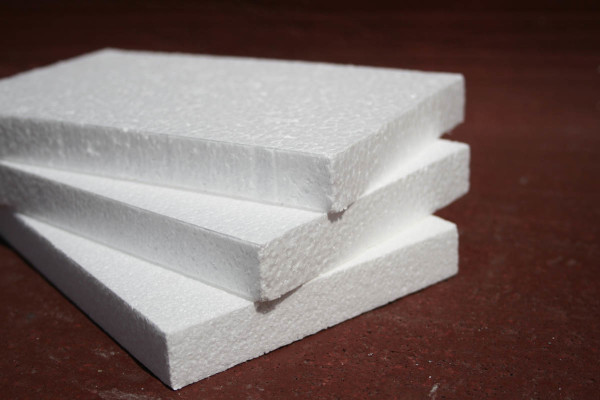
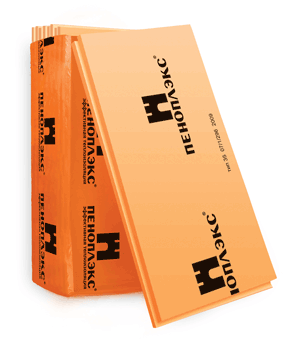
Installing a new radiator on the loggia or transferring the old one
I want it to be warm in the new attached living space, and here the solution seems to be the transfer of the heating radiator from the hall or kitchen to the loggia. This is a gross mistake that you should not even think about: taking the heating radiator out of the outer (bearing) wall is strictly prohibited. This is fraught with heat supply accidents (for example, freezing of pipes), and you will never get permission for such arbitrariness. And if you still redo it this way, then you will have to return the pipes and the radiator to their original position at your own expense. Is there a way out? Of course, there is - electric floor heating. Modern technology allows you to make efficient and safe floor heating by laying a special electric cable.Moreover, for maximum heat transfer, the laying step can be varied depending on the planned heating temperature. I do not like? Instead of a water radiator, you can hang an oil electric heater in the same place, which will do the same job.
The sequence of work when warming the loggia
It is necessary to clean the walls, floor and ceiling of the loggia from old facing materials. Large gaps in concrete loggias should be covered with concrete mix.
Glazing

Loggia preparation
If required, then the old balcony door and window are dismantled, if the loggia is combined with the room. For a wider opening, part of the wall is knocked out. It must be remembered that the association of the loggia is a redevelopment, therefore, all actions must be coordinated with the BTI.
- Check the walls and floor again. All holes must be filled with mounting foam. After the foam has dried, a lubricating waterproofing must be applied to the lower part of the walls.
- Floor leveling. Use cement-sand mixtures.
- Waterproofing to protect against moisture.
Floors, walls and ceilings are sheathed with waterproofing material such as roofing felt or expanded polyethylene film. This is necessary so that condensation does not accumulate on the heat-insulating material. The roofing material is overlapped, glued to the base, gluing the joints with a gas burner. Instead of roofing felt and film, penetrating waterproofing is used, which is a thick mixture. It is applied with a roller or brush. You can also use polyurethane, painting mastics.
Floor insulation
The floor should be warm, durable and light. There are several options for insulation:
- the floor surface can be covered with expanded clay and make a screed;
- instead of expanded clay, heat-insulating material (pressed foam, extruded polystyrene foam) can be glued to the floor, a gypsum fiber sheet can be glued on top;
- set wooden logs, place the selected insulation in the empty space, then nail the tongue-and-groove boards onto the logs;
Wall and ceiling insulation
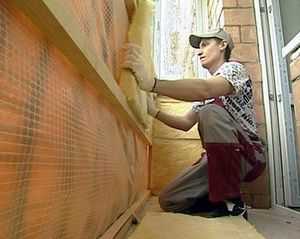
Sheathing with finishing material. For cladding, you can use moisture-resistant drywall, rack or wooden lining, wall panels. A 1.5 cm air gap is left between the facing material and the insulation using an attached wooden crate, which is attached to the concrete wall with self-tapping screws. On this frame, the selected cladding is fixed: drywall, lining. When facing with drywall, the joints between the plates are sealed with putty. They also use a glass mesh with small cells. The ceiling can be made suspended, under which to hide the wiring.
Floor covering is laid on the floor. It can be a euroboard up to 4 mm thick.Many people prefer to lay linoleum or carpet after laying wood flooring. When the option of floor insulation using a concrete screed is used, then an electric floor heating system is installed. Removing central heating is prohibited by building codes. Or use heaters and electric fireplaces for heating. With individual heating in the room, you can install a radiator under the windowsill on the loggia.
Installation of skirting boards, sockets and switches.
Thus, the insulation of the loggia will depend on the goal pursued and on the available budget.
Link to article
The loggia is often used as an office, a place to relax, a small gym, a winter garden and even a bedroom. Considering that initially this room was not intended for such needs, one cannot count on special warmth inside. The only way out is to insulate the loggia! Properly selected insulation will protect you from the cold in winter, and save you from the heat in summer. For more information on how to choose a heater for a loggia, see our article.
Before discussing the choice of materials, let's say a few words about possible ways to insulate the loggia. Warming is preferably carried out outside, since in this case the dew point (condensate formation point) will be outside the room. Moisture will evaporate quickly, and the walls will be dry and warm. In addition, external insulation helps to save the already small space of the loggia.
However, it is much more difficult to implement external insulation with your own hands than internal insulation, which is why most opt for the latter. It is about him that we will talk in this article.
With internal insulation, the dew point is inside the room, so there is a high risk of condensation and premature damage to the insulation, the appearance of wet spots on the walls and insufficient thermal insulation. To prevent this from happening, it is necessary to provide a vapor barrier during installation or use materials that do not absorb moisture (for example, penoplex).
For warming the loggia, materials such as:
- mineral wool,
- Styrofoam,
- penoplex,
- penofol or isolon,
- expanded polystyrene.
Each of the materials has both its pluses and minuses.
Mineral wool
There are only three options for mineral wool: basalt, slag and glass wool. It is sold both in rolls and in briquettes. According to their properties, glass and basalt wool are approximately the same. Slag wool is made from low-quality raw material, but despite this, it has good thermal insulation properties, and it also has a low price.
Styrofoam
The second option for insulation is foam. The sheet material is made of expanded polystyrene, is not afraid of water, fungi and bacteria, under normal conditions, the expiration date of the foam is about 50 years. A foam sheet can replace 40 cm of a wooden wall, a meter of expanded clay concrete and 4 meters of concrete. Styrofoam can be pasted over the floor, walls, and ceiling. After pasting, it remains only to tighten the insulation with a reinforcing mesh, apply a facing mixture, putty, paint - and you're done!
Penoplex
You can also insulate the loggia with penoplex. This is a modern material that is easily mounted on a special glue. The functions of foam plastic are similar to foam plastic, but there are a number of differences. Firstly, there will be much less debris after working with the material. Secondly, penoplex has a higher density.
Izolon and penofol
These materials are polyethylene insulation, covered with foil on one or both sides. Both penofol and isolon are used to insulate walls, floors and ceilings. Due to their heat-reflecting properties, heaters completely block the loss of heat from the heated room. Another visible plus of the material is its small thickness.Izolon and penofol can be used as independent materials, but nevertheless, for the best thermal insulation, they are usually used in combination with other heaters, for example, foam.
Styrofoam
An excellent insulation for the loggia is polystyrene foam. The material is great for floor insulation, because it has high strength and is able to withstand any load. If it is not planned to combine the loggia with the living room, you can get by with 30 mm thick polystyrene foam. If the loggia will be combined with the room, you will need a 50 mm thick insulation.
Preparatory work
Before you start warming the loggia with your own hands, you need to clearly plan the future range of work, the cost of materials, missing tools, etc.
If the insulation of the loggia is detailed on paper, all materials have been calculated and prepared, then we proceed to the next important stage - preparation for installation
- We remove all unnecessary items and furniture from the premises.
- Carefully put in order the ceiling and floor of the room (we sweep away all the garbage).
- We remove recesses, cracks in the ceiling, for this you can use mounting foam or sealant for interior work.
- Leave the treated surface to dry completely.
- We clean up all the roughness.
- We produce steam and waterproofing of the ceiling. To do this, we use a two-millimeter polyethylene film or a special membrane, connecting all joints with liquid nails or ordinary construction tape. The vapor barrier oilcloth should fit snugly against the ceiling.
- Take measurements, transfer the markings to the material and prepare the amount of insulation you need.
After the high-quality preparation of the ceiling of the loggia for installation, we proceed to its thermal insulation.
First priority
Before proceeding with the insulation of the balcony, it should be glazed
Why is glazing important? Old or low-quality windows will give enormous heat losses, therefore it is pointless to insulate the balcony if the windows are blown out at the same time. It is better to entrust the installation of windows to professionals who will carry out installation using modern technologies.
After installing the windows, you should decide where it is better to insulate. Of course, it is recommended to insulate the outer walls of the balcony, which will prevent the development of such problems as: moisture settling on the walls and the appearance of fungal mold. But to insulate a balcony, if it is at a high altitude, is not easy enough. To do this, you will need to call climbers-builders who will request a considerable amount for services. And one more important point - in order to insulate the balcony from the outside, the approval of the authorities will be required, since by your actions, you plan to change the design of the facade of a residential building.
As a result, the last option remains - to insulate the balcony from the inside. Moreover, such work can be performed independently if you have the necessary tools. Many apartment owners do not want to pay big money for balcony insulation, therefore, in order to save money, they decide to insulate the balcony on their own. This article will tell you: how to carry out the insulation of the balcony yourself, what material to choose for this and what are the main steps for performing the work.
How to choose a heater for a loggia or balcony correctly
The balcony is a special design, and it is not recommended to make it heavier. And if you take into account that before the insulation you will need to install double-glazed windows, which will entail strengthening the fence, then the insulation should be made of minimally lightweight materials.
To begin with, it must be said that all materials for insulation have a different structure and installation method. Some, such as isolon, are sold in a roll, others - polystyrene and foam, have a solid, porous structure, others are soft and elastic like cotton wool.It is easiest to work with those materials that are harder, but they do not fully meet the requirements of insulation. For greater thermal insulation, they have to be supplemented with isolon.
Basic requirements for heaters:
- Low thermal conductivity;
- Resistance to deformation from temperature changes;
- Ecological cleanliness;
- Strength under mechanical action;
- Ease of installation;
- Resistance to dampness, water, heat;
- Durability;
- Compatibility with other materials.
When doing repair work, it must be borne in mind that some materials, such as polystyrene, have disadvantages. Almost all of them are destroyed when exposed to solvents, can crumble and break under load.
Thermal insulation with foam
Laying insulation on the ceiling is not always carried out as the final element of the installation of the loggia. Sometimes it is completely absent, which is why the owner of the room loses in coziness, comfort and quality of heat.
The simplest way, which does not require a lot of time for thermal insulation, is considered to be laying with penofol. The installation looks like this:
- We make accurate measurements of the length and width of the surface.
- We transfer the dimensions to a roll of building foam foam, after which we cut off the required amount of material.
- We install the first layer of thermal insulation using transverse wooden slats (3-4 pieces are enough).
- We clean all recesses and joints with a special sealant or mounting foam.
- We wait until the surface is completely dry.
- We carry out the installation of the second layer of insulation, using already longitudinal rails. The finished ceiling structure must be connected without defects to the thermal insulation of the walls.
- You can fix the finish using external slats that form a flat surface.
Thermal insulation of the ceiling of the loggia with penofol, including high-quality insulation of the floor and walls, will retain a significant part of the heat of your apartment in the winter. And self-installation of loggia insulation will save you a good amount of money, because. penofol is one of the easiest materials to process and relatively inexpensive.
How best to insulate a balcony from the inside: tricks and tips from a professional
Practice shows that it is best to insulate balconies from the inside with penoplex and penofol. It is better not to use mineral wool for this. Although she is soft and comfortable, she does not like dampness. And temperature drops on the balcony are inevitable, therefore, condensate as well.
Styrofoam, 4-5 cm thick will be enough to insulate the walls of the balcony. As an adhesive, use liquid nails, or special glue. Do not use for gluing heavy mixtures. In order for the repair to progress in stages, and the finishing materials do not interfere with each other, perform the work in a certain sequence.
Stages of work on the insulation of the balcony:
- Install plastic windows;
- It is best to start the insulation of the balcony from the ceiling;
- After finishing it, go to the floor.
- Lastly, the walls are insulated.
If you do everything right, then in the end your repair will converge into one harmonious idea.
Stages of thermal insulation work
Before insulating the loggia inside, a number of preparatory work is carried out:
- glazing and sealing of all cracks between the frames and the wall, parapet;
- surface preparation;
- waterproofing.
As glazing, double-glazed windows with frames made of any material are chosen. They must be functional, have a ventilation mode and be light enough not to create additional load on the floor slab.
Walls, ceiling, floor are pre-cleaned of debris and other contaminants, check the integrity of the surface. If cracks and tile gaps are found, they are filled with sealant. Align if necessary.
An important approach to correctly and better insulate the loggia is to create a layer of waterproofing.To do this, use one or more materials, since it is necessary to waterproof the parapet and all external walls, floors, ceilings, frames.
Waterproofing materials include:
- ruberoid;
- penofol;
- various types of coating, painting substances;
- penetrating waterproofing;
- foilisolon.
Rolled waterproofing is glued overlapping to the base, and the seams are sealed with sealant, sealed with special adhesive tape or soldered, as is the case with roofing material. When coated with foil isolone, an additional layer of thermal insulation is obtained. The use of coating, painting, penetrating insulation is justified in hard-to-reach places and in the case when the dimensions of the room are very small.
After determining which insulation is best for the loggia and carrying out preliminary work, proceed directly to the insulation itself. There are two ways:
- a continuous layer of heat-insulating material is created and any options for steam penetration to the insulation are minimized;
- laying insulation and covering it with a vapor barrier.
Warming methods
First.
In this case, materials with low vapor permeability are used: polystyrene foam, polystyrene foam. Their thickness must be such as to create the required resistance to the passage of steam and at the same time be sufficient for the necessary thermal insulation. In the case of using tile insulation, the sequence of work is as follows:
- diluted tile adhesive;
- glue is applied at the corners of the plate and in the center;
- the plate is applied to the surface and holes are drilled through it with a perforator up to 6 cm deep under the dowels;
- through the drilled holes with the help of dowel mushrooms, the final fastening is carried out, a minimum of 5 dowels is used;
- the next slab is also laid after checking the surface with the rule;
- the seams between the plates are sealed with mounting glue or glued with adhesive tape;
- it is possible to lay a second layer of insulation, for example, penofol;
- after laying all the sheets, fiberglass reinforcement is carried out;
- putty for leveling the texture of the grid.
Reinforcement is carried out in four stages:
- process the plates with a sandpaper with a coarse grain size;
- cover the plates with glue up to 3 mm thick;
- a fiberglass mesh with cells measuring 5x5 mm is pressed into the glue;
- apply a second layer of glue over the mesh.
You can also use rolled thermal insulation materials, the laying technology will not change. In this case, pieces of insulation of the required size are cut off. After such insulation, surfaces are obtained that are completely ready for painting, decorative plaster, pasting with liquid wallpaper or any other decorative material.
Second.
For this method, there are no restrictions on the choice of insulation, since the technology provides for the creation of a vapor barrier between it and the decorative finish. Such insulation is carried out with the help of arranging a wooden crate or without it, but then the crate for fixing drywall, lining, PVC plates is made on top of the vapor barrier.
The crate is made of wooden beams or metal fasteners and a profile. In the case of metal parts, insulation must be laid under them.
The height and width of the crate depends on the type of insulation:
- for mineral wool, the bars are selected with a smaller width than its mats, so that the laying is carried out side by side;
- it is advisable to lay several layers of cotton wool so as to cover the bars, then they will not become conductors of cold;
- for polystyrene, all parameters of sheets and bars must match.
After laying the insulation in the crate, a vapor barrier material is overlapped to it. It can be ordinary polyethylene, a membrane. All joints of the vapor barrier are glued with adhesive tape. If the lining with insulation was carried out without a crate, then profiles for mounting the finish are attached on top of the vapor barrier.
https://youtube.com/watch?v=H1se6Fl6Nms
The floor is not properly insulated
In order not to overload the floor slab (for example, with a concrete screed or leveling mixture), it is better to make the floor covering from lightweight modern materials. On top of the vapor barrier - foil or polyethylene film - two layers of foam or mineral wool mats are laid. Above - waterproofing, which can be used, for example, hydrostekloizol. Rolls are placed on top with an overlap of about 10-20 centimeters. With the help of a blowtorch, mastic-based strips are fused together, and if the use of open fire is impractical or dangerous for some reason, then the sheets are mechanically fastened together. Then a layer of plywood, and only then carpet or laminate.
Finally, the “classic” way of floor insulation is also not bad: wooden logs are laid on the slab, between which modern insulation materials are located.
Methods for fixing insulation
There are two ways to fix the insulation. The first way is to fasten it directly to the wall surface using fungal dowels or glue. The second way is to install a heater in a specially mounted wooden or metal niche.
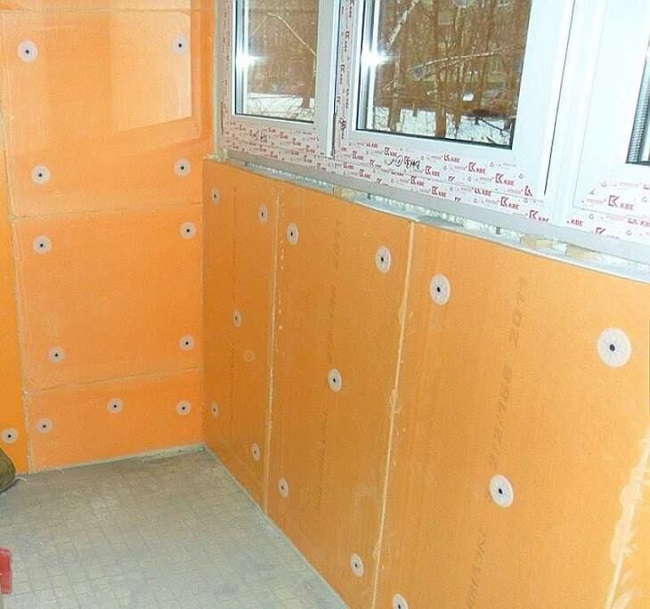
To attach the insulation to the surface on the dowel-fungi, you will need to make a small hole in the heaters, drill a hole in the wall and drive a plastic dowel into it. Then install the dowel-fungus into the insulation and pull it to the wall with a self-tapping screw.
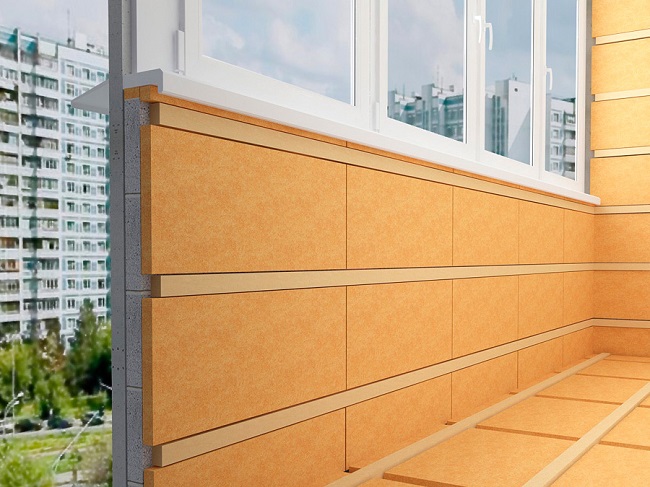
To make a frame, you will need to prepare wooden bars with a thickness equal to the thickness of the insulation. The bars must be treated with a special anti-rotting solution. These bars must be fixed along the entire perimeter on the floor and on the ceiling, as well as around the entire perimeter of the parapet. It is necessary to fix a bar on the floor that will divide the floor along the balcony into two parts.
